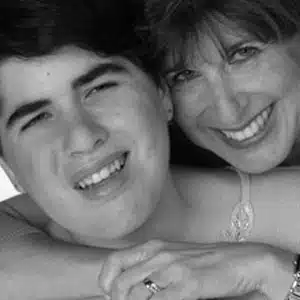At first we thought Julie, then three years old, had swallowed something and that it had become caught in her throat. She sounded as if she was choking and she was quickly turning blue. My husband tried to clear her throat and was preparing to do CPR when Julie began having the unmistakable tonic-clonic contractions that would be a manifestation of her seizures for years to come.
During those next 17 years Julie has had seizures at the Milwaukee Zoo. She’s had seizures at Disney World. She’s had seizures while we were driving at 65 mph down the Edens Expressway in Chicago. She had a seizure during her brother’s Bar Mitzvah, and at more Passover dinners than I care to remember. She’s had seizures all alone in the bathroom, as we stood outside the door that was blocked by her body, listening helplessly to her head hitting the door. She’s had seizures on airplanes, and while we tried to navigate security at airports. She’s had seizures in swimming pools and on top of climbing bars.
Julie’s seizures were partially controlled with medication until puberty. We tried a dozen medications, sometimes up to four at a time, without improvement. I pushed to try every new drug combination,and became angry when others wanted to give up. My husband, Jim, a physician, understood that after two or three failures, drugs were unlikely to help, and Julie was at increased risk of status epilepticus (nonstop seizing). I didn’t realize that Julie could die from the seizures, or that frequent seizures would affect her cognitive abilities. We had never heard of SUDEP (Sudden Unexplained Death from Epilepsy) at that time.
Eventually, surgery was our only option. In 1999, at age 14, Julie underwent her first surgery, a left temporal lobectomy. Within five months, her seizures returned, just as she was starting high school. She attended school as best she could, sitting in a wheelchair with a nurse beside her at all times. I sat outside the classroom in the hallway. After one or two classes, I would take her home where she would sleep and have seizures the rest of the day. She lost 40 pounds, due to medication side effects, and was disappearing from us… physically and cognitively.
Further testing revealed that Julie had a diffuse cortical malformation of the left side of her brain, and so a different type of surgery was suggested–a functional hemispherectomy, which would disconnect her malformed left hemisphere from the rest of her brain. This procedure would hopefully prevent the spread of the seizures. The price was high. We were told she would lose the function of her right arm and hand, and the entire right side of her body would be weakened.
We didn’t understand the full implications and the extraordinary challenges ahead during her post-operative rehabilitation. We only knew that we were losing our precious daughter, and that we had this chance to save her. The decision wasn’t hard. We felt lucky that she was a candidate for this surgery.
Rehabilitation was long and difficult. She had to relearn to walk, talk, and retrain bowel and bladder control. Julie required years of physical, occupational and speech therapy. She still does not have functional use of her right arm or hand and has lost her vision in the right side of each eye. She drools profusely. Over the next two and a half years, Julie’s seizures gradually returned. Her third surgery in less than six years was performed in 2005, removing more brain tissue and severing any remaining connections between her left and right hemispheres. Although her seizures are now controlled, there remains one small focus in her remaining right hemisphere that requires the ongoing use of two medications.
Julie’s story has had an indelible impact on our entire family. Our other children, Lindsay and Michael, had childhoods of uncertainty, worry and fear and, I’m sure, to some degree, embarrassment. The constant monitoring and care required by Julie’s special needs took time and attention away from her siblings. Michael’s childhood was punctuated by extended stays out of state for Julie’s surgeries, and Lindsay found herself alone at numerous parent weekends at college. They have always been Julie’s greatest cheering squad, but we know that Julie is not the only one who has paid a high price. The physical and mental strain of caring for Julie often sapped all of our energy and patience.
We were introduced to CURE Epilepsy in 1999 shortly after Julie’s first surgery. CURE Epilepsy gave us hope. For the first time we dared to think that scientists could develop cures for these aberrant neurological explosions that destroy the quality of life, and even life itself for so many.
I became active in fundraising and reaching out to other families. In April 2005 Jim testified before Congress on the need for increased funding for epilepsy research and joined CURE Epilepsy’s Lay Research Board, participating in the grant review process. We were pleased to be Honorary Co-chairpersons of CURE Epilepsy’s 2006 Annual Benefit. In 2004 we held the first ‘Drive for CURE Epilepsy’ golf outing. The outing which ran for ten years was a product of the love and support of our friends and extended family. During that time we raised over a million dollars for cutting edge research, sponsoring three CURE Epilepsy Challenge grants through the Julie’s Hope Award.
Our family is grateful for the opportunity to continue to support CURE Epilepsy and channel our feelings of helplessness and desperation into working together for a cure. It is too late for Julie as she has suffered significant consequences from epilepsy, but hopefully future generations will not have to suffer the dire effects of this disease. Parents should not have to lead their children into operating rooms, knowing they are sacrificing their child’s arm and hand for the mere chance at seizure control. A family should never have to lose a loved one to epilepsy.





